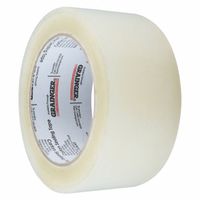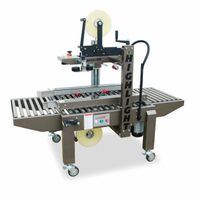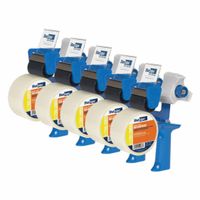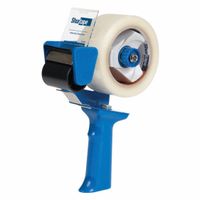Call +(254) 703 030 000 / 751 483 999 / 721 704 777
- Home
- Packaging Shipping
- Packaging Tapes Dispensers Machines
- Standard Packaging Tapes Dispensers Machines
.....Read More
Frequently Asked Questions
What is the difference between acrylic and hot melt packaging tape?
Acrylic and hot melt packaging tapes differ primarily in their adhesive properties, performance characteristics, and ideal usage conditions.
Acrylic packaging tape uses a water-based acrylic adhesive. It is known for its excellent UV resistance, making it suitable for long-term storage and exposure to sunlight without yellowing or losing adhesion. Acrylic tape performs well in a wide range of temperatures, from cold to hot, and maintains its adhesive properties over time. It is ideal for sealing boxes that will be stored for extended periods or shipped over long distances. Acrylic tape is also less affected by aging, providing a consistent seal over time.
Hot melt packaging tape, on the other hand, uses a synthetic rubber-based adhesive. It offers a stronger initial tack and superior adhesion to a variety of surfaces, including recycled corrugated boxes. Hot melt tape is known for its quick bonding and is often used in high-speed packaging operations. However, it is less resistant to UV light and extreme temperatures compared to acrylic tape. Hot melt tape is best suited for short-term storage and applications where immediate adhesion is critical.
In summary, acrylic tape is preferred for long-term storage and exposure to varying environmental conditions, while hot melt tape is ideal for applications requiring strong initial adhesion and quick bonding.
How do you load a packaging tape dispenser?
To load a packaging tape dispenser, first ensure you have the correct size tape for your dispenser. Begin by locating the end of the tape roll and peeling it back slightly to expose the sticky side. Hold the dispenser in one hand and place the tape roll onto the dispenser's spindle, ensuring the sticky side of the tape faces downwards and away from the handle.
Next, pull the tape's loose end through the slot between the roller and the metal or plastic guide plate. Ensure the tape is aligned properly and not twisted. Pull the tape over the roller and under the guide plate, allowing a few inches to extend beyond the cutting blade.
Once the tape is threaded, test the dispenser by squeezing the handle to advance the tape. The tape should move smoothly over the roller and cut cleanly when pressed against the blade. Adjust the tension knob, if available, to ensure the tape dispenses easily without excessive slack or tightness.
Finally, ensure the cutting blade is sharp and unobstructed for clean cuts. Your packaging tape dispenser is now loaded and ready for use.
What are the benefits of using a tape dispenser?
A tape dispenser offers several benefits that enhance efficiency and convenience in various settings, from offices to homes and industrial environments.
1. **Time-Saving**: Tape dispensers allow for quick and easy access to tape, eliminating the need to search for the tape end. This speeds up tasks such as wrapping, sealing, and packaging.
2. **Precision and Neatness**: They provide a clean and straight cut, ensuring that the tape is applied neatly and consistently. This is particularly important in professional settings where presentation matters.
3. **Ease of Use**: With a tape dispenser, users can operate it with one hand, freeing the other hand to hold or position the item being taped. This is especially useful in multitasking environments.
4. **Safety**: Tape dispensers often come with a built-in blade that is safely housed, reducing the risk of cuts and injuries compared to using scissors or knives.
5. **Waste Reduction**: By providing precise cuts, tape dispensers help minimize tape wastage, which can be both cost-effective and environmentally friendly.
6. **Ergonomics**: Many tape dispensers are designed to be ergonomic, reducing strain on the hands and wrists during repetitive tasks.
7. **Stability**: Desktop tape dispensers are weighted, providing stability and preventing the dispenser from moving during use, which enhances accuracy and ease.
8. **Versatility**: Tape dispensers come in various sizes and types, accommodating different tape widths and applications, from small office tasks to large industrial jobs.
9. **Cost-Effectiveness**: By improving efficiency and reducing waste, tape dispensers can lead to cost savings over time, making them a valuable investment for businesses and individuals alike.
Can packaging tape be used in extreme temperatures?
Packaging tape can be used in extreme temperatures, but its effectiveness depends on the type of tape and the specific conditions. Standard packaging tapes, such as acrylic or hot melt tapes, have temperature limitations. Acrylic tapes generally perform well in a wide range of temperatures, from as low as -40°F (-40°C) to as high as 140°F (60°C), making them suitable for both cold storage and warmer environments. Hot melt tapes, on the other hand, are better suited for moderate temperatures, typically ranging from 45°F (7°C) to 120°F (49°C).
For extremely cold conditions, such as those found in freezers or arctic environments, specialty cold-temperature tapes are recommended. These tapes are designed to maintain adhesion and flexibility at temperatures well below freezing. Conversely, in extremely high temperatures, such as those encountered in industrial settings or during shipping in hot climates, heat-resistant tapes are advisable. These tapes are formulated to withstand prolonged exposure to high temperatures without losing adhesion or structural integrity.
It's important to note that the surface to which the tape is applied also affects performance. Surfaces should be clean, dry, and free of oils or dust to ensure optimal adhesion. Additionally, the initial application temperature is crucial; even tapes designed for extreme temperatures may require application at moderate temperatures to achieve a strong bond before being exposed to extreme conditions.
In summary, while packaging tape can be used in extreme temperatures, selecting the appropriate type of tape for the specific environmental conditions is essential to ensure reliable performance.
How do you choose the right packaging tape for your needs?
To choose the right packaging tape, consider the following factors:
1. **Purpose and Application**: Determine the type of items you are sealing. For lightweight packages, standard acrylic tape may suffice. For heavier or valuable items, opt for reinforced or filament tape.
2. **Adhesive Type**:
- **Acrylic**: Suitable for long-term storage and resistant to temperature fluctuations.
- **Hot Melt**: Offers strong adhesion and is ideal for quick sealing.
- **Natural Rubber**: Provides excellent adhesion on various surfaces, even in cold environments.
3. **Tape Material**:
- **Polypropylene**: Common and cost-effective, suitable for general use.
- **PVC**: Offers a quieter unwind and is more durable, ideal for heavy-duty applications.
4. **Environmental Conditions**: Consider the storage and shipping conditions. For cold or humid environments, choose tapes with strong adhesive properties like hot melt or natural rubber.
5. **Width and Thickness**: Wider and thicker tapes provide better strength and are suitable for larger or heavier packages. Standard widths are 2 to 3 inches, with thickness ranging from 1.6 to 3.1 mils.
6. **Color and Customization**: Use colored or printed tapes for branding or to indicate special handling instructions.
7. **Cost**: Balance between quality and budget. Higher-quality tapes may cost more but offer better performance and reliability.
8. **Ease of Use**: Consider tapes that are easy to apply, especially if using a dispenser. PVC tapes are generally easier to handle due to their flexibility.
By evaluating these factors, you can select a packaging tape that meets your specific needs, ensuring secure and efficient sealing of your packages.
What are the common problems with packaging tape dispensers and how to fix them?
Common problems with packaging tape dispensers include:
1. **Jamming**: Tape can get stuck or not feed properly. To fix this, ensure the tape is loaded correctly, with the sticky side facing down. Clean the dispenser to remove any adhesive residue that might be causing the jam.
2. **Tape Tearing**: Tape may tear unevenly or not at all. Check the blade for dullness or damage. Replace the blade if necessary. Ensure the tape is aligned properly and the tension is adjusted to prevent tearing.
3. **Misalignment**: Tape may not align with the cutting blade. Reposition the tape roll and adjust the tension arm to ensure proper alignment. Make sure the tape is centered on the roller.
4. **Blade Dullness**: A dull blade can make cutting difficult. Regularly inspect and replace the blade to maintain sharpness. Clean the blade to remove any adhesive buildup.
5. **Tension Issues**: Incorrect tension can cause the tape to unwind too easily or not at all. Adjust the tension knob or screw to achieve the desired resistance.
6. **Handle Discomfort**: Extended use can cause discomfort. Consider using a dispenser with an ergonomic handle or adding padding to the existing handle for comfort.
7. **Tape Slippage**: Tape may slip off the roller. Ensure the tape is tightly wound and the core fits snugly on the dispenser. Adjust the tension to prevent slippage.
8. **Inconsistent Cutting**: If the tape cuts inconsistently, check the blade alignment and sharpness. Ensure the tape is fed straight and the dispenser is used at the correct angle.
Regular maintenance, such as cleaning and checking for worn parts, can prevent many of these issues.
How do packaging tape machines work?
Packaging tape machines, also known as case sealers or carton sealers, automate the process of sealing boxes with adhesive tape. These machines streamline packaging operations, ensuring efficiency and consistency. Here's how they work:
1. **Box Feeding**: The process begins with boxes being fed into the machine, either manually or via a conveyor system. The boxes must be properly formed and filled before entering the machine.
2. **Box Sizing**: Some machines are adjustable to accommodate different box sizes, while others automatically adjust to the box dimensions. This ensures that the tape is applied correctly to each box.
3. **Flap Folding**: For uniform sealing, the machine folds the top flaps of the box. This can be done manually or automatically, depending on the machine's design.
4. **Tape Application**: The machine uses a tape head to apply adhesive tape. The tape head is equipped with a roll of packaging tape and a cutting mechanism. As the box passes through, the tape is dispensed and pressed onto the box's surface.
5. **Sealing**: The tape is applied to the center seam of the box, sealing the top and/or bottom flaps. Rollers or brushes may be used to press the tape firmly onto the box, ensuring a secure seal.
6. **Cutting**: Once the tape is applied, a cutting blade slices the tape, completing the seal. The machine is designed to cut the tape cleanly to avoid any loose ends.
7. **Discharge**: The sealed box is then discharged from the machine, ready for shipping or further processing.
Packaging tape machines can be semi-automatic or fully automatic, with features like adjustable speed, tape tension control, and integration with other packaging systems for enhanced productivity.





